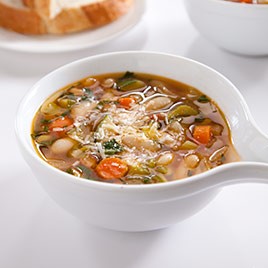Hearty Minestrone

If you are pressed for time you can “quick-brine” your beans. In step 1, combine the salt, water, and beans in a large Dutch oven and bring to a boil over high heat. Remove the pot from the heat, cover, and let stand 1 hour. Drain and rinse the beans and proceed with the recipe. We prefer cannellini beans, but navy or great Northern beans can be used. We prefer pancetta, but bacon can be used. To make this soup vegetarian, substitute vegetable broth for chicken broth and 2 teaspoons of olive oil for the pancetta.
Parmesan rind is added for flavor, but can be replaced with a 2-inch chunk of the cheese ( adding a plain 2-ounce chunk of Parmesan adds flavor and texture closest to that of the original recipe. The only downside: It left stringy melted cheese in the pot. To remove it, slowly pour the cooked soup into a clean pot, leaving the cheese strands stuck to the bottom of the old pot). In order for the starch from the beans to thicken the soup, it is important to maintain a vigorous simmer in step 3. The soup can be cooled, covered tightly, and refrigerated for up to 2 days. Reheat it gently and add basil just before serving.
Table salt
1/2 pound dried cannellini beans (about 1 cup), rinsed and picked over
1 tablespoon extra virgin olive oil , plus extra for serving
3 ounces pancetta , cut into 1/4-inch pieces (see note below)
2 medium celery ribs , cut into 1/2-inch pieces (about 3/4 cup)
1 medium carrot , peeled and cut into 1/2-inch pieces (about 3/4 cup)
2 small onions , peeled and cut into 1/2-inch pieces (about 1 1/2 cups)
1 medium zucchini , trimmed and cut into 1/2-inch pieces (about 1 cup)
2 medium garlic cloves , minced or pressed through garlic press (about 2 teaspoons)
1/2 small head green cabbage , halved, cored, and cut into 1/2-inch pieces (about 2 cups) (see step by step below)
1/8 - 1/4 teaspoon red pepper flakes
8 cups water
2 cups low-sodium chicken broth
1 piece Parmesan cheese rind , about 5 by 2 inches (see note)
1 bay leaf
1 1/2 cups V8 juice
1/2 cup chopped fresh basil leaves
Ground black pepper
Grated Parmesan cheese , for serving
1. Dissolve 1 1/2 tablespoons salt in 2 quarts cold water in large bowl or container. Add beans and soak at room temperature for at least 8 hours and up to 24 hours. Drain and rinse well.
2. Heat oil and pancetta in large Dutch oven over medium-high heat. Cook, stirring occasionally, until pancetta is lightly browned and fat has rendered, 3 to 5 minutes. Add celery, carrot, onions, and zucchini; cook, stirring frequently, until vegetables are softened and lightly browned, 5 to 9 minutes. Stir in garlic, cabbage, 1/2 teaspoon salt, and red pepper flakes; continue to cook until cabbage starts to wilt, 1 to 2 minutes longer. Transfer vegetables to rimmed baking sheet and set aside.
3. Add soaked beans, water, broth, Parmesan rind, and bay leaf to now-empty Dutch oven and bring to boil over high heat. Reduce heat and vigorously simmer, stirring occasionally, until beans are fully tender and liquid begins to thicken, 45 to 60 minutes.
4. Add reserved vegetables and V8 juice to pot; cook until vegetables are soft, about 15 minutes. Discard bay leaf and Parmesan rind, stir in chopped basil, and season with salt and pepper. Serve with olive oil and grated Parmesan.
Have a V8
Though completely nontraditional, V8 juice trumped all the other types of tomato products we tried in our soup. It added just the right amount of bright tomato taste with an even bigger wallop of vegetable flavor—the real goal of our recipe. We’re surprised the Italians didn’t think of it first.
Note: Many people keep bacon on hand, but rarely have pancetta in the refrigerator. Can bacon be substituted for pancetta?
Bacon and pancetta are both cut from the belly of the pig, but the products are not identical. Bacon is cured with salt, then smoked and sliced. Pancetta (sometimes called Italian bacon) is cured with salt, black pepper, and spices and rolled into a cylinder. It is never smoked.
Replacing pancetta with bacon won’t ruin a dish, but because bacon is overtly smoky, many recipes recommend blanching it before swapping it for pancetta. To test the validity of this practice, we made our recipes for Hearty Tuscan Bean Stew and Pasta with Greens and Beans, first blanching bacon in boiling water, then proceeding with the recipe, subbing the blanched bacon for pancetta.
As we prepared the recipes, we noticed that blanching had removed a considerable amount of the fat from the bacon. In fact, for the stew recipe, we had to supplement the bacon with a small amount of oil to properly sauté the aromatics. And when we tasted the finished dishes, we noticed that despite the blanching, subtle hints of smokiness remained. Even so, tasters deemed the substitution acceptable.
Our conclusion: If you want to eliminate most of its smoky flavor, blanch bacon in boiling water for two minutes before swapping it for pancetta. Because blanched bacon is not as fatty as pancetta, you may need to add extra oil to the recipe.